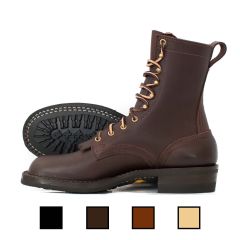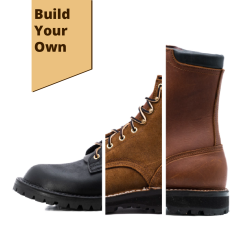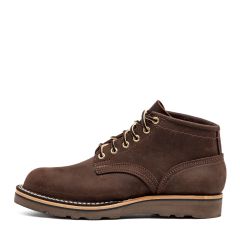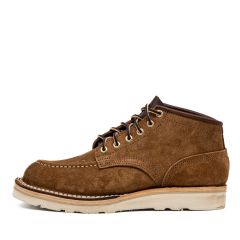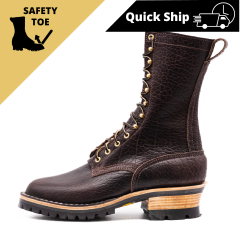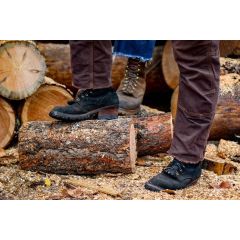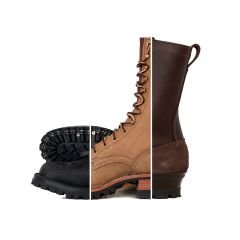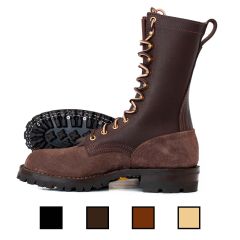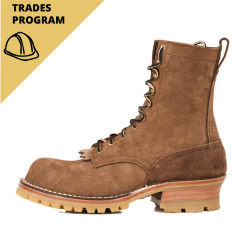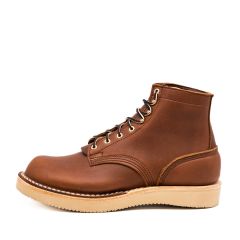Construction Boots
What Are Construction Boots?
Construction boots are specialized footwear designed to protect your feet in rugged environments—like construction sites, industrial settings, or any job that demands durability and support. These boots aren’t just about safety; they also play a key role in comfort, stability, and long-term foot health for those on their feet all day.
Typically made with tough materials like full grain leather and heavy-duty rubber, construction boots provide resistance to abrasion, punctures, and harsh weather conditions. They often feature reinforced toe caps (such as steel or composite), slip-resistant soles, and supportive outsoles to help prevent injuries from falls, impacts, or prolonged strain.
While there are many brands out there, Nicks Boots takes a standout approach by crafting boots with premium materials and an emphasis on longevity. Their construction boots are built not just for protection, but for performance and comfort over the long haul.
Top Nicks Boots Construction Boots
Nicks Boots is renowned for its handcrafted, American-made boots built to withstand the toughest work environments. Whether you're on the job site or looking for rugged everyday wear, their lineup offers a range of durable and customizable options. Below is a curated list of their top construction boots to consider:
365 Stitchdown MTO
A heritage-inspired moc toe boot crafted with stitchdown construction and a wedge sole, perfect for casual or light-duty wear. This made-to-order model allows for extensive customization in leather, sole, and finish.
Aldert Strider
The Aldert Strider features a sleek 6-inch profile with a wedge sole, combining comfort and minimalism. It's well-suited for everyday urban use while retaining rugged durability.
Strider Moc Toe – Classic Configuration
A moc toe version of the Strider line, this model offers a more casual aesthetic with classic stitchdown construction. Ideal for those who value both function and form in their everyday footwear.
Americana Heritage Boot
This classic 6-inch boot with a cap toe channels traditional American workwear vibes. Its moderate arch and heritage leather options make it versatile for work or casual settings.
Bison BuilderPro – 55 Last
Built from rugged bison leather on the high-arch 55 last, this boot is designed for heavy-duty performance. Its classic configuration emphasizes long-lasting support and durability.

BuilderPro Skywein’s Contender
A limited collaborative version of the BuilderPro line, Skywein’s Contender features unique design tweaks tailored for serious work use. It balances form and function in a bold, durable package.
BuilderPro HD
Engineered for high-durability demands, the BuilderPro HD incorporates robust materials and reinforced construction. Ideal for tradespeople or anyone who puts their boots through intense wear.
BuilderPro HD – Quick Ship
A ready-to-ship version of the BuilderPro HD, offering the same rugged features with limited configuration options. Perfect for those needing premium work boots without the long wait.
BuilderPro Contender
A reliable, all-purpose work boot with customizable configurations to suit a range of jobsite needs. It offers a balance of comfort, toughness, and classic Nicks craftsmanship.
Why Quality Matters In Construction Boots
When you’re working in demanding environments, your footwear isn't just gear—it’s essential equipment. The quality of your construction boots can directly impact your comfort, productivity, and safety on the job.
Durability That Withstands Daily Wear
Low-quality boots might be cheaper up front, but they often break down quickly. Soles separate, stitching unravels, and leather cracks. High-quality boots like those from Nicks Boots are built to endure daily punishment thanks to premium full grain leather and hand-built construction that resists wear over time.
Support For Long-Term Foot Health
Quality construction boots provide structured support that helps reduce fatigue and stress on your feet, ankles, and knees. With solid arch support, cushioned insoles, and durable midsoles, they make long shifts more manageable—especially on hard or uneven terrain.
Safety You Can Rely On
Whether you’re stepping over rebar or climbing scaffolding, you need boots that won’t let you down. Quality boots use thick leather and sturdy rubber outsoles to provide reliable protection, slip resistance, and grip—even in wet or unstable conditions.
A Long-Term Investment
Rather than buying a new pair every year, a high-quality boot like those from Nicks often lasts several times longer with proper care. That means fewer replacements, better foot health, and more value over time.
The Materials Behind Nicks Construction Boots
At the core of every Nicks construction boot is a commitment to top-tier materials—chosen not just for durability, but for performance in the toughest conditions. Nicks doesn't cut corners with synthetic fillers or shortcuts. Instead, they rely on tried-and-true materials that are trusted by hardworking professionals.
Full Grain Leather: Built To Last
Nicks uses full grain leather, the strongest and most durable part of the hide. Unlike “genuine leather” or synthetic alternatives, full grain retains the natural fibers, which makes it tougher and more resistant to wear and tear. It forms to your foot over time, offering a personalized fit without relying on artificial customization.
This type of leather also has natural water resistance and breathability, helping keep your feet dry and comfortable throughout long shifts. And while it may take some time to break in, the result is a boot that molds to your foot and gets better with age.
Heavy-Duty Rubber Soles
The outsoles of Nicks boots are made from high-performance rubber, designed to provide traction, shock absorption, and slip resistance. Whether you’re walking on gravel, rebar, or wet plywood, you’ll get reliable footing and protection from impact and punctures.
Minimal Synthetic Materials
One of the standout qualities of Nicks construction boots is their lack of unnecessary synthetic materials. This makes the boots not only more durable, but also better for breathability, comfort, and long-term performance.
The Craftsmanship Of Nicks Boots
What sets Nicks Boots apart isn't just the materials—they’re backed by generations of craftsmanship. Every pair is built with precision and care in their Spokane, Washington workshop, where skilled bootmakers follow time-honored techniques to ensure each boot stands up to real-world demands.
Handmade, One Step at a Time
Unlike mass-produced alternatives, Nicks construction boots are handcrafted from start to finish. That means real people inspect, cut, stitch, and assemble every component—ensuring attention to detail you simply won’t find on an assembly line.
Goodyear Welt Construction
Each pair features Goodyear welt construction, a hallmark of high-quality boots. This method not only makes the boots exceptionally durable but also allows for resoling. Instead of tossing your boots when the sole wears down, you can renew them—extending their life by years.
Precision Fit Through Skill, Not Gimmicks
While Nicks doesn’t rely on terms like “custom fitting,” their craftsmanship results in a fit that feels naturally supportive over time. The full grain leather forms to your feet through wear, while the boot structure provides reliable support without high-tech gimmicks or synthetic padding.
Benefits Of Wearing Nicks Construction Boots
Choosing Nicks means choosing performance, protection, and longevity. Whether you're on a construction site, in a workshop, or just need all-day support, these boots deliver real-world advantages that outlast and outperform the rest.
Long-Term Comfort
Once broken in, full grain leather offers a comfort level that synthetic or low-grade boots simply can't match. The leather naturally conforms to the shape of your feet, offering personalized support while maintaining breathability and flexibility throughout long days.
Exceptional Durability
Nicks boots are built to handle harsh work environments. With thick leather uppers and rugged rubber outsoles, they're designed to resist cuts, abrasions, and breakdowns—holding up where cheaper boots wear out quickly.
Safety-Driven Design
From slip-resistant soles to sturdy construction that helps shield against impacts and punctures, Nicks construction boots offer critical protection without compromising mobility or comfort.
Resoleable And Repairable
Thanks to their Goodyear welt construction, these boots can be resoled when worn down—giving you the option to maintain your favorite pair for years rather than constantly replacing them.
Made In The USA
Every pair is built in Spokane, WA, with U.S.-sourced materials whenever possible. That’s a commitment to quality and integrity you can stand behind—literally.
Shop Nicks Construction Boots
Ready to experience the difference that craftsmanship and quality make? Nicks construction boots are made for the long haul—with full grain leather, heavy-duty rubber soles, and handmade construction that stands up to the harshest conditions.
Whether you're looking for something rugged for job sites or a reliable everyday work boot, Nicks offers a variety of builds to suit your needs. And since every pair is made in the USA, you know you're getting unmatched attention to detail and long-term value.
Browse the full range of work boots at Nicks Boots Construction Collection. Each model includes detailed specs and build information, so you can find the right combination of toughness, comfort, and style for your workday.
Read also:
- Classic Cowboy Boots vs. Roper Boots: What's The Difference?
- Hot Shot Fire Boots vs. Other Wildland Boots
- Pull-On Boots vs. Lace-Up Boots: A Detailed Comparison
Frequently Asked Questions about Construction Boots
What is the difference between construction boots and regular work boots?
While all construction boots are work boots, not all work boots meet the safety and durability standards needed for construction. Construction boots typically offer reinforced toe protection, puncture-resistant soles, and thicker materials to handle harsher environments.
Are construction boots waterproof?
Not all construction boots are waterproof by default. However, many high-quality leather boots like those from Nicks can be made water-resistant with proper care and treatment, such as conditioning and using waterproofing waxes.
Do construction boots have to have steel toes?
Steel toes are common, but not mandatory. Some boots use composite or alloy toe caps, which can still meet safety standards while being lighter and sometimes more comfortable in extreme temperatures.
Can construction boots be worn casually?
Yes. Many people wear construction boots casually due to their rugged style and long-lasting comfort. Brands like Nicks offer models that blend everyday wear with work-level durability.
How can I tell if a boot is made from full grain leather?
Full grain leather has a natural grain texture and may show slight imperfections or character marks from the original hide. It's thicker, more durable, and doesn’t have an artificial grain stamped on like lower-grade leathers.
What boot height is best for construction work?
It depends on your work conditions. 6-inch boots offer more flexibility, while 8-inch and taller boots provide better ankle support and protection against debris or rough terrain.
Do construction boots expire or go bad if unused?
High-quality boots, especially those made with full grain leather, won’t expire if stored properly. Keep them in a dry, ventilated place away from direct sunlight and they’ll last for years—even without frequent use.
Can I replace the insoles in my construction boots?
Yes. Replacing insoles is a common way to refresh comfort without buying new boots. Make sure the insoles are compatible with the boot’s structure to avoid fit issues.
Are construction boots suitable for cold weather?
Yes—especially if paired with insulating socks or thermal linings. Full grain leather provides some natural insulation, and some models are designed specifically for winter use.
What makes American-made construction boots better?
American-made boots often emphasize craftsmanship, ethical labor practices, and locally sourced materials. Brands like Nicks prioritize hand-built quality over mass production, which often results in longer-lasting, higher-performing footwear.
